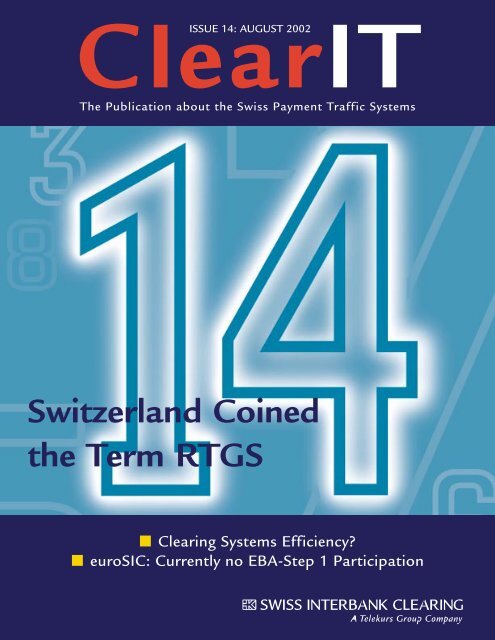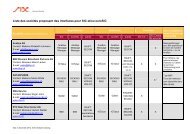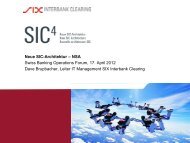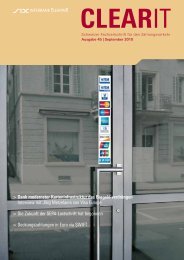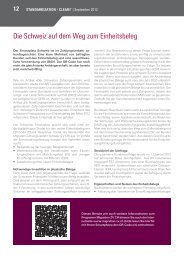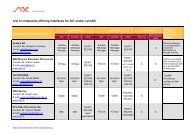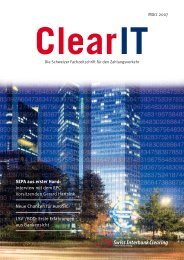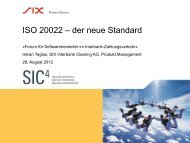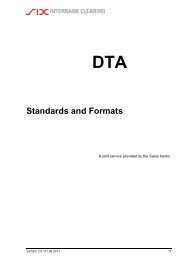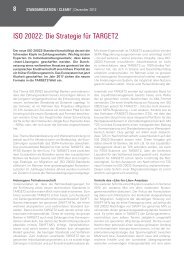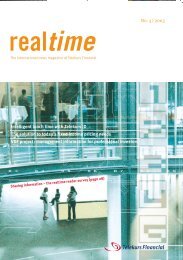No. 14 – Aug 2002 - SIX Interbank Clearing
No. 14 – Aug 2002 - SIX Interbank Clearing
No. 14 – Aug 2002 - SIX Interbank Clearing
You also want an ePaper? Increase the reach of your titles
YUMPU automatically turns print PDFs into web optimized ePapers that Google loves.
CIearIT<br />
ISSUE <strong>14</strong>: AUGUST <strong>2002</strong><br />
The Publication about the Swiss Payment Traffic Systems<br />
Switzerland Coined<br />
the Term RTGS<br />
■ <strong>Clearing</strong> Systems Efficiency?<br />
■ euroSIC: Currently no EBA-Step 1 Participation<br />
| 10 |
EDITORIAL<br />
Dear Reader,<br />
As of this writing on June 10, <strong>2002</strong>, it is exactly 15 years to the day that the Swiss franc clearing system SIC started its operation. More<br />
specifically, it was the fully computerized Telekurs SIC system replacing the old, partially manually operated SIC. But who can still remember<br />
«B.C.» – Before Computerization? Who remembers that after several years the completed, «new» SIC still couldn’t be started up for another<br />
entire year? That’s how long it took just for all the rigorous certification testing. Only then was it started up.<br />
Somehow that doesn’t seem to fit in with our times. Maybe SIC’s fathers hadn’t yet heard about the Time to Market concept, and knew nothing<br />
about the fact that it really isn’t the big fish eating the small fry, but rather that the faster one gets the slower one in the end. For that matter,<br />
they probably never even considered that a payback period shouldn’t ever exceed 24 months (not years!).<br />
<strong>No</strong>netheless, SIC turned itself into a success story of the finest order – and continues to write history. And if we look around the Telekurs Group,<br />
we quickly realize that there are a host of other endurance performers: The Telekurs Financial value data system is still going strong after its recent<br />
25th anniversary. The old faithful Investdata system was operated for exactly as many years. Then there is DTA and LSV, celebrating the same<br />
anniversaries. The ATM is still being centrally monitored after 24 years, for over 17 years ec-direct cards are a preferred payment method<br />
at gas stations and for <strong>14</strong> years at a number of ever increasing cash registers across the country. Each one of these anniversaries represents a<br />
remarkable success story. And then there are those products showing all the potential of becoming one in the future. There is CASH, introduced<br />
six years ago, or euroSIC, now up and running for four years and going strong.<br />
As you can surmise, I am out to promote endurance. Like any good athlete knows, it takes more than sheer speed to succeed on the field. You can’t<br />
lose your breath if you want to make it for the long haul. Maybe some day some management expert will develop a new theory based on that<br />
philosophy. He or she will go to great lengths to explain to the reader that, in order to really succeed in today’s world of hectic pace and<br />
continuous change it takes more than speed, agility and assertiveness: it takes endurance.<br />
Endurance is one of the true marks of Telekurs.<br />
Dr. Georg Kramer,<br />
Chief Executive Officer, Telekurs Holding AG<br />
CONTENT<br />
3— Switzerland Coined the Term RTGS – Interview with Stephan Zimmermann<br />
5— <strong>Clearing</strong> Systems Efficiency<br />
7— Postfinance and SIC<br />
8— SWIFT in Switzerland<br />
10— euroSIC – Currently no EBA-Step 1 Participation<br />
11— DTA and LSV Changes<br />
| 2 |
Stephan Zimmermann:<br />
«Switzerland Coined the<br />
Term RTGS»<br />
At the end of May, Stephan Zimmermann,<br />
Head of Operations at UBS AG,<br />
turned over his mandate as President of<br />
the board of directors of Swiss <strong>Interbank</strong><br />
<strong>Clearing</strong> AG to Bruno Pfister of<br />
Credit Suisse. As President of the board<br />
of directors of Telekurs Holding AG he<br />
continues to contribute his knowledge<br />
and experience to the joint venture.<br />
ClearIT had the opportunity to interview<br />
Mr. Stephan Zimmermann shortly after<br />
the transition.<br />
ClearIT: Mr. Zimmermann, the development of<br />
Swiss <strong>Interbank</strong> <strong>Clearing</strong> has been significantly<br />
impacted by your vision over the past six years.<br />
Today SIC is one of the world’s strongest RTGS<br />
systems – any reflections?<br />
Stephan Zimmermann: I will remember<br />
this time as a very positive experience. It<br />
was extremely satisfying to purposefully<br />
approach the relevant topics affecting the<br />
Swiss payment traffic together with a<br />
team of dedicated, professional and pragmatic<br />
managers and board of directors.<br />
There are three points I especially want to<br />
focus on:<br />
•| With SIC Switzerland has literally coined<br />
the term RTGS long before it became a<br />
characteristic feature for all modern clearing<br />
systems.<br />
•|<br />
The cooperation between the Swiss<br />
National Bank and the commercial banks,<br />
regardless of their respective sizes, is<br />
exemplary and various economic models<br />
can be realized in a short amount of time.<br />
SWISS INTERBANK CLEARING<br />
•| The economies of scale work, which<br />
means that SIC has indeed proven<br />
remarkably effective both for small and<br />
large amounts. The SIC system is a global<br />
cost leader – and will remain one in future<br />
years.<br />
Especially the second point remains a very<br />
positive memory. To make changes to<br />
their RTGS system CHIPS, the USA<br />
require up to 11/2 years. In Switzerland<br />
all we need is an AM meeting with all the<br />
parties, including the SNB, sitting at the<br />
same table. The decisions are noted right<br />
then and there. This is very unique indeed.<br />
ClearIT: What does the future for SIC look like?<br />
Stephan Zimmermann: <strong>Clearing</strong> systems<br />
are no exception – they have to undergo<br />
continued adaptation to the economic<br />
changes. The most crucial adaptations for<br />
our clearing system are addressed with<br />
SIC3 and some have already been implemented.<br />
remoteGate, multi-currency<br />
capability, DTA renewal, as well as the<br />
continued opening of the system, such<br />
as in the cross border area, are good<br />
examples of SIC adaptations.<br />
Of course Postfinance plays a very important<br />
role, too. Postfinance is a SIC system<br />
participant no different than any of the<br />
others. Participation as a shareholder in<br />
Swiss <strong>Interbank</strong> <strong>Clearing</strong> AG is currently<br />
being discussed. One of the main deciding<br />
factors for future development is the<br />
full integration of all market participants.<br />
| 3 |<br />
This is simply mandatory for feasibility<br />
and acceptance reasons.<br />
Of course staying true to the mission and<br />
the purpose of the SIC system is always a<br />
determining issue for future developments:<br />
To provide the Swiss financial<br />
market with an efficient, inexpensive and<br />
secure clearing system. <strong>No</strong> more, no less.<br />
ClearIT: The European payment landscape is in<br />
the midst of several changes with the introduction<br />
of the cash euro and the new clearing<br />
systems RTGSplus and Step 2. Which development<br />
potentials do you envision for euroSIC?<br />
Stephan Zimmermann: The first thing to<br />
mention here is that euroSIC isn’t actually<br />
a competitor to RTGSplus or Step 2. This<br />
would be a very lopsided perception.<br />
However, euroSIC and the SECB Swiss<br />
Euro <strong>Clearing</strong> Bank GmbH are well established<br />
in the market and are providing<br />
Swiss financial institutions a reasonably<br />
priced option for their euro payments<br />
with swisseuroGate. The transaction<br />
volume increase for this year makes me<br />
feel optimistic for the future.<br />
Looking down the road, I don’t believe<br />
that Europe will need 15 clearing systems.<br />
A homogenous market will only require<br />
one good clearing system. But it’s probably<br />
safe to predict that even in a distant<br />
future there will be more than one system.<br />
ClearIT: During our last interview two years ago<br />
(ClearIT <strong>No</strong>. 6) you mentioned that the appropriate<br />
networking, tapping into the European
Stephan Zimmermann has worked at<br />
UBS AG, formerly the Swiss Bank Corporation,<br />
since his commercial apprenticeship.<br />
For 13 years after receiving his<br />
Masters in Business Information Technology<br />
he managed the processinc centers<br />
in London, Singapore, and Frankfurt<br />
as Operations Manager. Stephan<br />
Zimmermann has been in top management<br />
since 1996. Currently he is in<br />
charge of Operations and is a member<br />
of the UBS AG Group Managing Board.<br />
In addition, he is the president of the<br />
board of Telekurs Holding AG as well as<br />
a board member of CHIPCo (US <strong>Clearing</strong><br />
House), SIS SEGAINTERSETTLE AG,<br />
SWIFT and SWX the Swiss stock<br />
exchange.<br />
development and a further opening of the SIC<br />
system are the major challenges. According to<br />
your opinion, how far has this integration progressed?<br />
Stephan Zimmermann: Today, any bank<br />
worldwide can participate in SIC so long<br />
as they meet the admission criteria. The<br />
technical requirements are already met<br />
with remoteGate and the generic system<br />
platform. The further opening of the<br />
system is becoming increasingly important<br />
in order to facilitate access to globally<br />
active financial institutions.<br />
Direct participation is of particular interest<br />
to those financial institutions who<br />
wish to benefit from the advantages of<br />
the Swiss Value Chain, such as the delivery<br />
versus payment process for securities<br />
transactions.<br />
As far as the development within the euro<br />
zone is concerned, we are only just at the<br />
beginning. With euroSIC a platform has<br />
been created providing the Swiss banks<br />
not only with an elegant, simple way to<br />
settle euro payments within Switzerland,<br />
but also access for payments within the<br />
euro zone. At the same time, it created a<br />
new way for EU banks to transfer euros to<br />
Switzerland.<br />
ClearIT: As the former board president of Swiss<br />
<strong>Interbank</strong> <strong>Clearing</strong> you were interested in reasonably<br />
priced systems and in a high payment<br />
volume, as the person in charge of UBS, on the<br />
other hand, you are having your banks’ crossborder<br />
payments in euro processed via proprietary<br />
access to the German clearing system and<br />
not via euroSIC. How would you explain these<br />
differing perspectives?<br />
Stephan Zimmermann: UBS is one of the<br />
most important financial institutions in<br />
securities and commercial banking. The<br />
question whether direct access to a<br />
system is or isn’t a requirement hinges in<br />
part on the institution’s individual risk of<br />
the commitment in a particular currency.<br />
If a bank considers direct liquidity steering<br />
in specific currencies a necessity, the<br />
resulting consequence dictates direct<br />
access to the appropriate markets. That’s<br />
why the UBS is a self clearer in euro as<br />
well as in other significant currencies,<br />
such as the dollar or the yen.<br />
The above notwithstanding, UBS has,<br />
right from the start, supported and taken<br />
part in the vision of the cooperative core<br />
of the Swiss financial market and significantly<br />
contributed to the development<br />
and implementation of euroSIC. This,<br />
knowing all along that UBS would only be<br />
able to effectively use certain parts.<br />
ClearIT: Large, global projects like Continuous<br />
Linked Settlement System or WATCH were realized<br />
either with tremendous delay or not at all.<br />
Are these indicators that the financial world is<br />
indeed not yet ready for world encompassing<br />
cooperation?<br />
Stephan Zimmermann: These two projects<br />
cannot be compared. The reasons<br />
behind the problems differ greatly. In the<br />
final analysis, WATCH was economically<br />
not feasible. That’s why not enough members<br />
could be committed who would have<br />
provided the necessary payment volume.<br />
| 4 |<br />
CLS is a different case. There are few<br />
things more complex than a global infrastructure.<br />
With CLS, features typical of<br />
global projects are clearly evident. They<br />
follow existing and developing markets<br />
and as a result almost always take longer<br />
and end up being significantly more<br />
expensive than originally anticipated. In<br />
addition, there have been many changes<br />
in personnel – almost none of the original<br />
developers are still involved. While this is<br />
the norm with global projects, it doesn’t<br />
make the situation any easier. CLS is also<br />
rather demanding in its content: to<br />
always have liquidity available at the<br />
appropriate locations 24/7 requires global<br />
bookkeeping – a rather considerable<br />
challenge in and of itself.<br />
But to make it in the market place involves<br />
another deciding factor altogether:<br />
The primary CLS mission concerns eliminating<br />
the fulfillment risks, the so-called<br />
Herstatt risk in response to the request by<br />
Stephan Zimmermann<br />
Photo: UBS
the regulators. So long as there is no fine<br />
for non-processing of settlement risks,<br />
there is no pressure to actually use CLS<br />
and cheaper solutions are still being<br />
researched.<br />
CLS will ultimately be introduced and will<br />
be successful. However, we will only learn<br />
to truly appreciate this new global payment<br />
system in a few years.<br />
ClearIT: For some time now SWIFT has been<br />
trying to reposition itself in the market with the<br />
introduction of new products. The limited<br />
acceptance of e-paymentsPlus seems to indicate<br />
that this might have been a step in the wrong<br />
direction. Which direction is SWIFT pursuing?<br />
Stephan Zimmermann: During the lifetime<br />
of any company, changing market<br />
tendencies have to be anticipated with<br />
product R & D, even though it is unpredictable<br />
what the market will actually do.<br />
And nobody got past the Internet bubble<br />
– SWIFT wasn’t immune either. <strong>No</strong>w that<br />
the bubble has burst, other challenges are<br />
demanding attention.<br />
SWIFT’s greatest strength and also its<br />
core business remains messaging: the<br />
transmission of financial transactions<br />
between banks over the world’s safest<br />
network. This main responsibility will be<br />
continually perfected.<br />
The entire financial industry is participating<br />
in SWIFT. This quite naturally predisposes<br />
SWIFT to be the perfect institution<br />
to push global standardization within<br />
the financial transaction industry. New<br />
standards are implemented according to<br />
new insights and perceptions. The standardization<br />
within the securities area is<br />
picking up speed. However, existing message<br />
types won’t necessarily be adapted<br />
<strong>Clearing</strong> Systems<br />
Efficiency<br />
Opinions differ about the best way to<br />
make a clearing system efficient. SIC,<br />
the Swiss franc clearing system is considered<br />
efficient.<br />
Christian Schwinghammer explains the<br />
different approaches.<br />
<strong>No</strong>wadays, the efficiency of clearing<br />
system settlement mechanisms is improved<br />
predominantly in one of two ways:<br />
By either resolving or avoiding system<br />
gridlocks or by reducing excessive<br />
liquidity.<br />
Both strategies are used in a series of<br />
liquidity-saving elements of systems such<br />
as the German RTGSplus , the British New-<br />
CHAPS or the Australian RITS. In these<br />
clearing systems offsetting is continually<br />
activated both bi- and multilaterally. The<br />
SIC system has been using a bilateral offsetting<br />
process since the end of 2001.<br />
| 5 |<br />
to new trends or technologies without<br />
noticeable added values, especially when<br />
considering that each innovation also<br />
requires system modifications for each<br />
participating bank. That’s why there isn’t<br />
yet an MT103 in XML format.<br />
Christian Schwinghammer,<br />
Swiss <strong>Interbank</strong> <strong>Clearing</strong> AG,<br />
christian.schwinghammer@sic.ch<br />
André Gsponer,<br />
Enterprise Services AG,<br />
andre.gsponer@eps-ag.ch<br />
In general, clearing systems work best<br />
when sufficient liquidity is available. The<br />
higher the liquidity, the lower the risk for<br />
gridlock, and the more efficient the<br />
system.<br />
The Cost Question<br />
Preparing liquidity reserves affects costs<br />
as much as the delayed settlement due to<br />
gridlock. At least in Europe the cost for<br />
liquidity is currently relatively low. As a
direct consequence many banks have not<br />
specifically developed their liquidity<br />
management.<br />
This means that a system operator may<br />
not have very high demands of the appropriate<br />
know-how of many of its participants.<br />
A customer friendly system design<br />
would take this into consideration.<br />
It is established that a more flexible liquidity<br />
approach, such as by providing free<br />
intraday credits, will result in significant<br />
savings. Beyond that, the splitting of very<br />
large payments is recognized as one of the<br />
most effective ways to prevent gridlocks.<br />
An efficient clearing system does not<br />
require extensive, liquidity saving mathematical<br />
algorithms be implemented.<br />
Disciplined behavior on the part of the<br />
system participants, preventative measures<br />
by the system manager, and appropriate<br />
price structuring are certainly suitable<br />
to support payments being settled<br />
efficiently as well as reasonably priced.<br />
Gridlock<br />
Caused by insufficient coverage. All<br />
system participants are unable to process<br />
pending payments.<br />
The Situation in Switzerland<br />
The willingness of the SIC participants to<br />
split payments of over 100 million CHF<br />
into several smaller chunks is an important<br />
prerequisite to successfully reduce<br />
the liquidity requirements of the clearing<br />
system. The risk of gridlocks occurring in<br />
SIC is indeed very small.<br />
Due to the close cooperation between the<br />
Swiss National Bank as the system manager<br />
with the participating banks, as well<br />
as to the efficient price structuring of the<br />
SIC systems 80 % of all the payments are<br />
already submitted. By 2 pm 80 % of the<br />
volume and 99 % of the number of transactions<br />
are already settled (see table).<br />
Switzerland’s financial market – and with<br />
it the SIC participants – is identified by<br />
Submitted, pending and settled payments per day (average during 2001)<br />
Table: D. Heller, Swiss National Bank, January <strong>2002</strong><br />
| 6 |<br />
the unique situation that two large participants<br />
lead the clearing system by transaction<br />
volume. That’s the reason the offsetting<br />
algorithm for the resolution of<br />
gridlocks introduced in December 2001 is<br />
adequate even though it only works on a<br />
bilateral basis.<br />
The comparatively small additional benefit<br />
presumably gained by a multilateral<br />
algorithm would hardly justify the effort.<br />
The marginal utility achieved by additional<br />
and more complex algorithms for<br />
gridlock resolutions also appears insignificant.<br />
Additionally, simulation results indicate<br />
that the liquidity saving algorithms are<br />
most efficient in systems with comparatively<br />
few transactions.<br />
However, transaction-wise SIC is one of<br />
the strongest RTGS systems worldwide,<br />
with enough new transactions and therefore<br />
enough new liquidity continually<br />
being added.<br />
Fortunately, Swiss <strong>Interbank</strong> <strong>Clearing</strong> is in<br />
a position where the implementation of<br />
complex, liquidity saving algorithms for<br />
the SIC system is not a necessity for some<br />
time, particularly due to the fact that the<br />
fundamental aspects such as the submission<br />
patterns of individual participants<br />
and the cooperation between system participants<br />
and system manager are well<br />
structured in Switzerland.<br />
Bilateral Offsetting<br />
It’s a simple principle: For each payment<br />
not immediately settled, an offsetting<br />
payment is sought on the recipient side.<br />
The use of these bilateral and simultaneous<br />
offsetting results in notably faster<br />
payment execution and shortened wait<br />
queues.
An overview of SIC and other RTGS systems<br />
Postfinance and SIC<br />
Established processes are changed with<br />
the full participation by Postfinance in<br />
the SIC system. What should banks be<br />
on the lookout for?<br />
When in <strong>No</strong>vember 2000 Postfinance<br />
came online with SIC, it rendered superfluous<br />
the Swiss National Bank’s (SNB)<br />
gate keeping function. The interbank payment<br />
traffic between banks and Postfinance<br />
has been simplified by as a result.<br />
In October 2001, as a second step, Postfinance<br />
also introduced the processing of<br />
customer payments as A messages.<br />
For the customer payment exchange via<br />
SIC the so-called C messages have been<br />
used for several years now. These transactions<br />
are exchanged by file transfer between<br />
Swiss <strong>Interbank</strong> <strong>Clearing</strong> and Post-<br />
BUSINESS & PARTNERS<br />
finance. The C messages are to be used<br />
for the time being, however a task force<br />
has been organized to develop the specifications<br />
for the merging of C into A messages.<br />
The <strong>Interbank</strong> Team<br />
The <strong>Interbank</strong> Team was assembled by<br />
Postfinance for the internal and organizational<br />
processes related to the SIC<br />
online access. The team handles all new<br />
responsibilities resulting from the SIC<br />
access, such as<br />
•| the processing of incorrectly submitted<br />
SIC entries with control and repair tools,<br />
•| the processing of manual fund transfer<br />
orders submitted via ZAG-FAX and SWIFT<br />
MT200,<br />
| 7 |<br />
This is particularly important because no<br />
matter how mathematically refined an<br />
algorithm is, it cannot compensate for a<br />
participant’s oversight.<br />
Christian Schwinghammer,<br />
Swiss <strong>Interbank</strong> <strong>Clearing</strong>,<br />
christian.schwinghammer@sic.ch<br />
•| reconciliation or booking of the SIC<br />
traffic (settlement account SNB) or<br />
•| balancing EFT/POS transactions and<br />
DTA input.<br />
The <strong>Interbank</strong> Team processes research<br />
for A and B transactions and operates the<br />
hotline for specific inquiries by the banks<br />
and by Swiss <strong>Interbank</strong> <strong>Clearing</strong>.<br />
Postfinance was able to develop in short<br />
order the required know-how while simultaneously<br />
developing an efficient network<br />
of relationships with the respective bank<br />
representatives in large part due to the<br />
concentration of multi-facetted assignments<br />
encountered by the <strong>Interbank</strong><br />
Team.
The First Experiences<br />
During these first months we became<br />
specifically aware of the following points<br />
the banks might want to take note of:<br />
•| When returning C11 messages via A11 to<br />
PF the reference number from field 33B<br />
must be submitted.<br />
•| The accurate representation of the<br />
account number (e.g. 30-3333-3) is<br />
important for automatic processing of<br />
B11 messages benefiting the banks’<br />
postal accounts.<br />
•|<br />
For transfer orders via SWIFT, field 57<br />
should contain the financial institution’s<br />
own clearing number, not the SNB’s<br />
number.<br />
The most efficient way to do this is via<br />
Yellownet (mask «Transfer into SIC»).<br />
These orders are processed automatically.<br />
Postfinance will continually match the<br />
online interface capacity as well as the<br />
organizational processes to the transaction<br />
volume.<br />
At this point the future shift from C to A<br />
messages and therefore from file to online<br />
interface is almost a given. As soon as the<br />
larger institutions are planning that step,<br />
Postfinance will be given ample notice in<br />
order to have enough time to prepare for<br />
the necessary adaptations.<br />
Bulk Payment Traffic<br />
Postfinance is using SIC for interbank<br />
business processing (B messages), high<br />
value payments and urgent payments. The<br />
| 8 |<br />
bulk payment traffic will still be processed<br />
by Postfinance, using their own existing<br />
services.<br />
Recently Postfinance has started to offer<br />
this new, bulk capable service for the processing<br />
of deposit slips to the banks: By<br />
using EGA-B (electronic credit advice with<br />
image) and EGA-V (electronic credit<br />
advice with image) deposit slips are being<br />
electronically notified and the current<br />
processes are simplified as a result.<br />
EGA-B and EGA-V together form a uniform<br />
standard for the credit notification,<br />
enabling the banks to streamline their<br />
subsequent processing, making it more<br />
efficient than the tradi-tional paper trail<br />
notifications.<br />
Patrick Bürki,<br />
Postfinance,<br />
buerkip@post.ch<br />
Alessandro Rausa,<br />
Postfinance,<br />
rausaa@post.ch<br />
SWIFT in Switzerland<br />
Within the financial industry, SWIFT has<br />
become a term everyone is familiar with<br />
by now. But what is SWIFT’s structure?<br />
Daniel Wettstein of the Swiss National<br />
Bank SNB, and SWIFT Switzerland<br />
chairman, offers a fascinating insight<br />
into the Swiss User Group of this multinational<br />
organization.<br />
The Society for Worldwide <strong>Interbank</strong><br />
Financial Telecommunication (SWIFT) is<br />
the network for processing global banking<br />
business. 7’300 participants from 196<br />
countries generate a message volume of<br />
up to 7.5 Million transactions per day.<br />
Switzerland, with a volume share of 5.5%<br />
ranks sixth among the participants, and is<br />
currently in a remarkable growth phase,<br />
especially in categories three and five –<br />
treasury and securities.<br />
But there is more to SWIFT – it is actually<br />
a standard. In its attempt to realize<br />
straight through processing (STP) the<br />
global banking business processing is<br />
dependent upon standardized message<br />
traffic and a secure network. Thanks to<br />
SWIFT the operational risk of the underlying<br />
business transactions and – almost<br />
as an aside – the costs are lowered.<br />
SWIFT is an open standard that can be<br />
used across all banking business transac-
tions and that has caught on in the<br />
banking industry internationally. Little by<br />
little, the proprietary standards of the<br />
various national processing systems are<br />
replaced by these standards, and Switzerland<br />
is no exception.<br />
They are developed by financial industry<br />
experts who are serving within international<br />
task forces. Due to its significant<br />
transaction volume and high turnover,<br />
Switzerland is very well represented and<br />
has considerable input affecting criteria<br />
and design.<br />
The SWIFT Standards Committee has<br />
implemented a new process, fundamentally<br />
changing the development of standards<br />
with the use of modeling techniques.<br />
The newly developed standards<br />
are formulated in the XML format<br />
(eXtended Markup Language) with the<br />
help of computer aided tools.<br />
Strong Representation<br />
of Interests<br />
SWIFT is a cooperative organized by<br />
Organigramm SWIFT<br />
countries. It has been in Switzerland since<br />
1974 in the form of SWIFT Switzerland<br />
National Member and User Group with<br />
250 members, submembers and participants.<br />
This organization ensures the representation<br />
of interests vis-a-vis SWIFT, within<br />
the framework of committee meetings. It<br />
primarily develops recommendations for<br />
the board papers, determines the admission<br />
criteria for Switzerland and processes<br />
and supervises the admission of participants.<br />
For the purpose of better use of the available<br />
resources there is close cooperation<br />
with the SKSF (Swiss Commission for<br />
Standardization within the Financial<br />
Industry). The SKSF with its trade commissions<br />
(Payments, Securities, Treasury<br />
Products, Trade Finance, Loan Transaction,<br />
Data Standards, IT Security,<br />
E-Commerce) processes all the standards<br />
and opinions for Switzerland, to the<br />
degree that they are SWIFT relevant.<br />
| 9 |<br />
Additional Info:<br />
Internet: www.swift.com<br />
Administrative Offices,<br />
SWIFT Switzerland:<br />
Phone +41 1 202 9400<br />
Fax +41 1 202 9401<br />
e-mail: swift.switzerland@bluewin.ch<br />
In addition, SWIFT Switzerland also<br />
focuses on specific problems like the<br />
SWIFTNet FIN migration. A task force is<br />
supporting the preparations for the network<br />
change with all SWIFT participants<br />
and the IT providers. There have already<br />
been three road shows with around 400<br />
participants. Additionally, SWIFT provides<br />
the participants with special support<br />
teams.<br />
Daniel Wettstein,<br />
Swiss National Bank,<br />
daniel.wettstein@snb.ch
euroSIC: Currently <strong>No</strong><br />
EBA Step 1 Participation<br />
Time and again euroSIC participants ask<br />
how they can process payments crediting<br />
Step 1 participants. Horst Sander<br />
and Christian Schwinghammer explore<br />
these options and explain why euroSIC<br />
will not become a Step 1 member for the<br />
time being.<br />
The SECB Swiss Euro <strong>Clearing</strong> Bank and<br />
Swiss <strong>Interbank</strong> <strong>Clearing</strong> as system manager<br />
and euroSIC system operator continue<br />
to perceive a lack of incentives to join the<br />
Euro Banking Association (EBA) payment<br />
system «Step 1» for small payments.<br />
Longer <strong>Clearing</strong> Times<br />
The euroSIC system is a true RTGS<br />
system, operating on the basis of instant<br />
finality with coverage. As a result, the creditor<br />
immediately has irrevocable access<br />
to any and all settled amounts in their<br />
accounts. The euroSIC clearing day ends<br />
at 6:45 pm on the settlement date which<br />
permits full advantage of the attractive<br />
TARGET cut-off times.<br />
The cut-off time for end-of-day processing<br />
for Step 1, on the other hand, is an early<br />
9:30 am on the settlement day, leaving a<br />
very limited amount of time to benefit<br />
from the TARGET cut-off times. This in<br />
and of itself speaks against a euroSIC<br />
participation in Step 1.<br />
The Step 1 funding process can last from<br />
10:30 am until 4:00 pm. Therefore, payment<br />
instructions by Step 1 members crediting<br />
euroSIC participants – while received<br />
by SECB by 9:30 am on the value<br />
date – can only be executed after 4:00<br />
pm, once the cover payment from the<br />
PRODUCTS & SERVICES<br />
Step 1 settlement bank has been received.<br />
Compare that with a bank choosing the<br />
swisseuroGate path: Payments can be<br />
submitted until either 4:15 pm (customer<br />
payments) or 5:15 pm (bank to bank payments)<br />
and still be settled the same day.<br />
Step 1 Has its Price<br />
SECB and Swiss <strong>Interbank</strong> <strong>Clearing</strong> are<br />
constantly striving to optimize the euro-<br />
SIC system’s cost structure. The tangible<br />
results of this policy are continually passed<br />
on to the participants in the form of<br />
low transaction fees and set pricing.<br />
One of the significant reasons against<br />
access to Step 1 is the additional costs<br />
resulting from such participation. This<br />
includes transaction costs, the installation<br />
and operating costs for a Step 1 work<br />
station plus the EBA joining and annual<br />
Step 1 membership fees.<br />
Add to this the Step 1 settlement bank<br />
fees – a requirement for processing and<br />
cover payments and with that an additional<br />
correspondence bank with a corresponding<br />
administrative effort for reconciliation<br />
and distribution.<br />
Another segment of the EBA clearing<br />
system worth exploring is the liquidity<br />
steering: It, too, would generate additional<br />
operational costs and requires<br />
tremendous additional effort and expenditure<br />
according to SECB’s evaluations.<br />
All these costs would have to be passed<br />
on to the euroSIC participants, breaking<br />
swisseuroGate’s low-cost pricing structure.<br />
The same holds true for the expenses<br />
| 10 |<br />
Back in <strong>No</strong>vember 2000 the trade<br />
organization Euro Banking Association<br />
(EBA) launched its new low value payment<br />
system «Step 1». Currently there<br />
are about 180 banks participating in the<br />
EBA clearing system.<br />
resulting from implementing and maintaining<br />
the EBA interface.<br />
swisseuroGate –<br />
a True-and-Tried Interface<br />
Today all euroSIC participants can reach<br />
any and all financial institutions connected<br />
to Step 1 within the EU – via swisseuroGate:<br />
Payments from the euroSIC<br />
system are routed via SECB and RTGSplus directly to the German Step 1 banks.<br />
All other Step 1 participants throughout<br />
the entire EU can be accessed indirectly<br />
via TARGET and the connected national<br />
RTGS systems (e.g. NewCHAPS in England,<br />
BI-REL in Italy or TBF in France).<br />
Going the other direction, payments<br />
between the EU and Switzerland can be<br />
swisseuroGate – the fast and least<br />
expensive way into the EU.
processed using the same route via swisseuroGate<br />
– just as simply, fast and<br />
affordably.<br />
The Bottom Line<br />
A euroSIC access to Step 1 does not offer<br />
any benefits to the Swiss banks. Quite the<br />
opposite is true: Currently it would be<br />
RTGS<br />
RTGS<br />
RTGS PLUS<br />
more expensive for euroSIC participants<br />
to route payments for a Step 1 member<br />
via EBA clearing than via swisseuroGate.<br />
While Step 1 certainly has its place in the<br />
market, it still makes sense for SECB and<br />
Swiss <strong>Interbank</strong> <strong>Clearing</strong> to hold off on<br />
obtaining access at this point.<br />
MT103 Germany - Switzerland<br />
Field Status<br />
SWIFT MT103<br />
Description Content<br />
F20 M Transaction Reference<br />
Number<br />
k85cmt<br />
F23B M Bank Operation Code CRED<br />
F32A M Value Date, Currency<br />
Code, Amount<br />
010312EUR5000,<br />
F50K M Ordering Customer Uhrengrosshandel<br />
Buxtehude<br />
F57A O Account With Institution BCCOCHFR<br />
F59 M Beneficiary Customer /1233-94852<br />
Horlogerie du Joux,<br />
Les Brenets<br />
F71A M Details of Charges SHA<br />
| 11 |<br />
Horst Sander,<br />
SECB Swiss Euro Cleraring Bank GmbH,<br />
horst.sander@secb.de<br />
Christian Schwinghammer,<br />
Swiss <strong>Interbank</strong> <strong>Clearing</strong> AG,<br />
christian.schwinghammer@sic.ch<br />
Check out our Cross-Border Guide on<br />
the Swiss <strong>Interbank</strong> <strong>Clearing</strong> website for<br />
different payment processing examples,<br />
such as how payments are routed<br />
correctly to your euroSIC account.<br />
Or determine the fees for individual<br />
payments.<br />
DTA and LSV Updates<br />
Due to the increased use of telebanking<br />
services over the past few years, banks are<br />
very interested in their customers electronically<br />
submitting all payments directly to<br />
their financial institutions. More and<br />
more banks are now equipped to accept<br />
DTA (Data Carrier Exchange) files directly<br />
and to subsequently process them within<br />
their own payment traffic applications.<br />
During its session in June <strong>2002</strong>, the Swiss<br />
<strong>Interbank</strong> <strong>Clearing</strong> Board of Directors has<br />
therefore decided to continue central DTA<br />
processing by Swiss <strong>Interbank</strong> <strong>Clearing</strong><br />
only until the end of 2005.<br />
The DTA format will continually be maintained<br />
and can still be used in future.<br />
A project task force is currently developing<br />
a migration and communication<br />
concept to be introduced in late summer<br />
or early fall.<br />
At that point the customers will be informed<br />
by the banks about the new<br />
options for submitting orders as well<br />
as about new products.<br />
Swiss <strong>Interbank</strong> <strong>Clearing</strong> remains the central<br />
processing point for LSV (Direct<br />
Debit) processing.<br />
You can find a wealth of information on<br />
this exclusive feature: Take advantage of<br />
our Cross-Border Guide at www.sic.ch<br />
Since an increase in transaction volumes<br />
is anticipated in LSV over these next years,<br />
the current processes will continually be<br />
improved and further automated. Additionally,<br />
the LSV service will be continually<br />
adapted to the new market demands.<br />
These service requirements with the working<br />
title «LSVnew» are currently being<br />
defined by a taskforce and will be published<br />
upon completion.<br />
Gottfried Keller,<br />
Swiss <strong>Interbank</strong> <strong>Clearing</strong> AG,<br />
gottfried.keller@sic.ch
From 30-09<br />
To 04-10<br />
Sibos<br />
Booth # H263<br />
Swiss <strong>Interbank</strong> <strong>Clearing</strong> is participating in Sibos for the third<br />
time. After Munich and San Francisco, and after a one-year<br />
hiatus, Sibos will be held in Geneva this year.<br />
Together with our booth-partners SIS SEGAINTERSETTLE AG<br />
and Telekurs Financial we hope to welcome you in Geneva.<br />
We will be providing information about:<br />
SIC<br />
euroSIC<br />
swisseuroGate<br />
remoteGate<br />
And ...<br />
The ever popular, traditional opening reception will be held<br />
Monday evening in conjunction with SWIFT and Swiss Plus.<br />
Don’t miss it!<br />
MASTHEAD | Publisher Swiss <strong>Interbank</strong> <strong>Clearing</strong> AG, Hardturmstrasse 201, CH-8021 Zürich, Switzerland |<br />
| Ordering/Feedback clearit@sic.ch | Issue <strong>14</strong> – <strong>Aug</strong>ust <strong>2002</strong> |<br />
| Published quarterly | Circulation German (1300 copies), French (400 copies), English (available in electronic format only) |<br />
| Editorial Team André Bamat, C.E.O., Swiss <strong>Interbank</strong> <strong>Clearing</strong> AG, Susanne Eis, SECB Swiss Euro <strong>Clearing</strong> Bank GmbH,<br />
Ruth Furter, Postfinance, André Gsponer, Enterprise Services AG, Beat Härry, Credit Suisse First Boston,<br />
Daniel Heller, Swiss National Bank, Bruno Kudermann, Editorial Manager, Swiss <strong>Interbank</strong> <strong>Clearing</strong> AG,<br />
Ulrich Merz, UBS AG, Alex Miescher, RBA-Service, Christian Schwinghammer, Swiss <strong>Interbank</strong> <strong>Clearing</strong> AG, |<br />
| Translations French Denis M. Fournier | English HTS | Layout Mirjam Steiner Advertisement Agency |<br />
| Printer Telekurs Print Shop |<br />
| Contact SIC SIC Operation Center +41 1 279-4200, Product Management +41 1279-4747,<br />
euroSIC euroSIC Operation Center +41 1 170-4700, Product Management +41 1 279-4747,<br />
SECB SECB Operation Center, +49 69 97 98 98 0, Customer Service SECB, +49 69 97 98 98 35 |<br />
| Additional information about the Swiss payment traffic systems can be found on the Internet at<br />
www.sic.ch or www.secb.de |<br />
| 10 |


